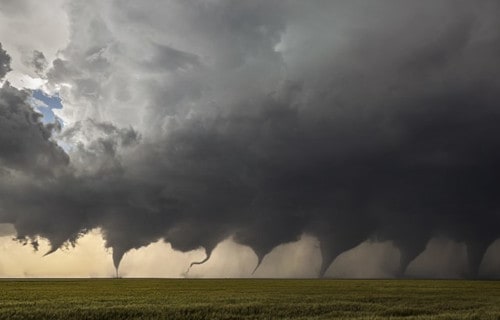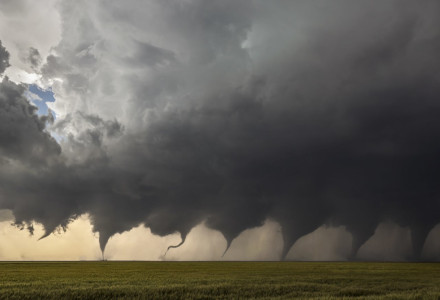
Since time immemorial, The Mighty Tornado has been among the most remarked on features of weather. These twisting and turning storms certainly captivate those who encounter them which often leaves them at a loss for words to convey the experience.
For some, these whirlwinds also represent examples of the extreme power and majesty of Nature. They become a focus of great appreciation and wonder. For others, though, these unstoppable juggernauts elicit extreme terror and often sheer panic.
Regardless of which camp people are, however, nearly all agree on one thing. The very nature of these massively powerful storms, replete with nearly unsurpassed destructive capabilities, makes experiencing them absolutely unforgettable.
Historically, as mankind learns about a force, he feels the need to quantify. This makes it easier to relate to. In the case of The Mighty Tornado, that’s now the Enhanced Fujita Scale. Meteorologists use this to rate the relative power and destructiveness of different storms.
EF0 Tornado
Although variations of the Fujita Scale exist, the one now employed in most countries remains the Enhanced Fujita Scale. These devastating storms further appear in many, but not all, parts of the world. In fact, they form on every continent, except Antarctica.
Twisters, as people sometimes refer to them, occur nearly everywhere but some regions remain more prone to them. Statistics show that approximately 75% of all tornadoes on earth happen in the United States, in North America.
On the currently used scale, the weakest version of The Mighty Tornado, at least in relative terms, remains the EF0 Tornado. Even that, however, ranks as quite powerful. By definition, tempests of this level display steady wind speeds of between 65 – 85 mph (105 – 137 kph).
Among this level of tornado, the property damage usually remains comparatively minor. This typically includes such destruction as small tree branches broken, minor damage to siding or gutters on houses, and occasionally shingles pulled off of some roofs.
EF1 Tornado
As one might expect, this next level of The Mighty Tornado steps things up a notch. That principle extends to both wind speed and degree of damage. Each step up also often includes an expanded width of the funnel. At this level, the structure becomes recognizable.
Though no precise correlation between strength and width of the funnel exists, the tendency remains for these to go hand in hand. This dimension for the storms also plays its own part in the level of damage and destruction left in the wake of the passing extreme weather event.
Storms of this power level also happen slightly less often than the, relatively speaking, weaker ones. As a general principle, the higher category of storm, the fewer of them occur. This trend holds true not only for each season, but over long periods of time as well.
EF1 Tornadoes, by current definition, have wind speeds of between 86 – 110 mph (138 – 177 kph). At that strength, damage amounts reach moderate levels, including broken glass and windows, heavily damaged roofs, and even mobile homes turned over.
EF2 Tornado
Naturally, the strength of the next rating of The Mighty Tornado raises the bar quite a bit. At this point, the degree of impact on affected areas begins to accumulate sever financial loss. Sadly, this also forms the start of the area of the scale where human lives are most often lost.
Thankfully, in most countries in which these deadly monsters of Nature occur, storms of higher levels rarely form. The lone exception remains the United States. Very nearly all of the strongest, largest, and most damaging tornadoes in the world take place there.
Twisters of this category begin to be considered monsters by many people. Few man-made structures can survive a direct hit by such forces of Nature. The more powerful storms most often, though not solely, occur in areas that happen to be less populated, fortunately.
Tornadoes of the EF2 level can have devastating effects on any community or forest they encounter. Those storms fitting into this category have winds ranging between 111 – 135 mph (178 – 217 kph). Again, these storms also generally possess greater diameters, as well.
EF3 Tornado
This power and size level of The Mighty Tornado begins to enter the category of the elite. To put this into perspective, globally each year, roughly 75 percent of all tornadoes hold a rating of either EF0 or EF1. Therefore, the rest remain quite rare.
Those rated at EF2 level account for about another 15 percent of the total. Following this, storms of level EF3 account for about 9 percent of all tornadoes worldwide. Considering the amount of damage inflicted by those of this level, that’s to be preferred.
Storms of this level of intensity almost always form in areas with extremely flat, broad terrain. This allows them to grow without anything to reduce their strength or size. As a result, these tornadoes represent the stereotypical tempests often portrayed in movies.
Impressively, an EF3 tornado develops steady winds of between 136 – 165 mph (218 – 266 kph). At that strength, the damage is severe. Even well constructed homes can be demolished by close approaches. Plus, cars can be lifted clear of the ground.
EF4 Tornado
At this level, examples of The Mighty Tornado are frequently, and not inaccurately, referred to as monsters. Fortunately, twisters of this strength and above comprise only around 1 percent of all tornadoes. That ratio holds true throughout the entire world.
Once again, location plays a role in these storms. That’s due to the fact that virtually all storms of this level and above occur within the United States. That’s a result of geography and sheer math. About 4 times as many tornadoes happen there than in all of Europe.
That ratio further extends to category EF4 tornadoes. Astoundingly, the power and degree of destruction climbs even higher among these monster storms. This level of storm packs steady winds of between 166 – 200 mph (267 – 320 kph).
With sustained winds of such great ferocity, the damage quite understandably becomes rated as Devastating. As a result, even strongly constructed homes and other buildings can be completely demolished. Objects as large as cars can be thrown great distances.
EF5 Tornado
And now we come to the cream of the crop of The Mighty Tornado, the dreaded EF5. These near-legendary monsters have been called the Godzilla of the weather world, and with just cause. No other weather related phenomenon packs so much force into the same area!
Mercifully, these monstrosities remain few and far between. That’s perfectly illustrated by their frequency even in the United States, sometimes dubbed Tornado Central. For example, during the 11 years between 2007 – 2018, only 9 reached this strength in that country.
This level also stands apart from the others for a unique reason. EF5 tornadoes have sustained winds in the funnel in excess of 200 mph (320 kph). Some occurrences exceed this, in fact. The highest officially recorded, in 1999, reached 301 mph (484 kph).
At this level, the damage becomes rated as Incredible. Well constructed buildings are not only leveled, but even their foundations can be erased. Even steel reinforced concrete structures can be destroyed, and cars and even trains thrown as much as 1 mi (1.6 km).
The Mighty Tornado
We hope that you have enjoyed this article about The Mighty Tornado. Opinions vary widely about these forces of Nature. But, appreciate them or fear them, one thing remains certain. These devastatingly strong storms are here to stay.
Interestingly, in the United States where the most intensive studies take place on the subject, a frightening trend appears. For roughly 40 years, tornadoes have been increasing in number.
Yet another, for some, terrifying fact exists. These same storms have not only been increasing in number, but also in average intensity. Though perhaps not as noticeably, due to the difference in base numbers, this trend extends throughout the world.
Recent and numerous scientific studies point to a direct correlation between this two-phase increase of the storms. The increase in number has been noticed only quite recently, but the rise in average strength has been ongoing for roughly 4 decades.
For the moment, the majority of meteorologists and other researchers remain loathe to commit themselves to an official diagnosis of a cause. However, a few make the case for a direct link between these trends and the ongoing effects of climate change.
Check out our other articles on 5 Rare Mind-Blowing Cloud Types, Earth’s Many Magnificent Marsupials, 6 Mysterious Natural Phenomena, Earth’s Many Stunning Waterfalls

